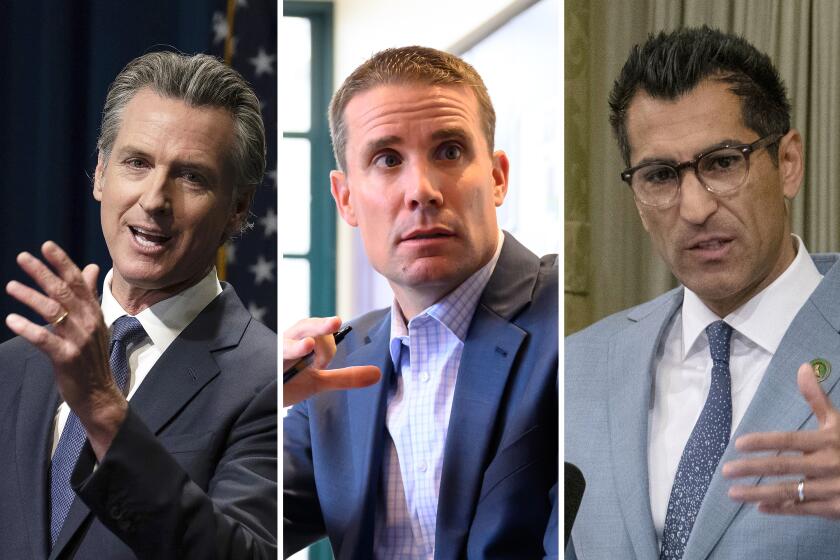Defense Fights Media Bid in Simpson Case : Courts: Judge is asked to deny request by news organizations to view photos of victims at the scene. Matter will be considered today.
- Share via
O.J. Simpson’s defense lawyers have asked a Los Angeles Superior Court judge to deny the request of several media organizations for limited access to photographs of the scene where Simpson’s ex-wife and Ronald Lyle Goldman were killed.
The defense lawyers contend that if the request to view the photos were granted, it probably would prejudice Simpson’s right to a fair trial and make it more difficult to impanel an impartial jury.
Simpson’s attorneys also urged that Judge Lance A. Ito deny the media organizations’ request to unseal transcripts of closed conferences held by another judge during Simpson’s preliminary hearing.
“Because the prejudicial value of the requested materials is great, the disclosure of the requested evidence would stifle the ability of both the defense and the prosecution . . . to impanel an impartial jury, especially in light of the unprecedented extent of the publicity generated in this case,” according to a brief filed Monday by Carl E. Douglas, one of Simpson’s 10 attorneys.
The brief was filed in response to a motion by Cable News Network, CBS, the Copley Press, the Los Angeles Times, Newsweek and USA Today asking for access to the material. Judge Ito is scheduled to hear the motion today.
During Simpson’s preliminary hearing last month, photos of the bloody bodies of Nicole Brown Simpson and Goldman were shown to witnesses who had found the bodies. But they were presented in such a way that they could not be seen by the courtroom audience, shown on live television or reproduced in any way.
“I just feel that if the media does have access to (the photos) . . . they will show (them) every time they talk about the case . . . that it’s just better, more prudent to not release the crime scene photos,” Municipal Judge Kathleen Kennedy-Powell said during a closed July 5 hearing, the transcript of which subsequently became public.
However, photos of pools of blood and a bloody glove were shown publicly.
On July 29, Los Angeles attorney Kelli I. Sager, representing the media organizations, formally asked Ito to allow the organizations “to have access to photographs used at the preliminary hearing, solely for the limited purpose of viewing the photographs, without making copies, videotaping or otherwise replicating the exhibits.”
She said the public and the press have a right to access under the 1st Amendment to judicial proceedings, including transcripts and other records of preliminary hearings, which can only be overcome by a showing that “closure is essential to preserve higher values and is narrowly tailored to that interest.” Sager said that there has been no such showing in this case.
However, Simpson’s lawyers retorted that there is no presumption of openness regarding the photographs because they were not shown at the preliminary hearing.
*
Meanwhile, police sources downplayed the significance of an ice cream vendor’s account of seeing Nicole Simpson on the evening of her death and of a partially frozen dessert found after her body was discovered. Bill Chang, the store manager of a Brentwood Ben & Jerry’s ice cream store, on Sunday said Nicole Simpson and an unidentified man came into the store with her children on the night of June 12.
Although sources close to the case said a police officer at the scene reported that a small container of a partially melted dessert was found inside Nicole Simpson’s condominium, law enforcement sources said there is no evidence supporting a defense theory that Nicole Simpson and Goldman were therefore alive later than police and prosecutors have suggested.
The evening was cool and police sources said that the officer who noticed the dessert did not document the extent to which it had melted.
Moreover, any suggestion that the victims were alive after about 10:30 p.m. is contradicted by other, more solid evidence in the case, police said.
During the preliminary hearing, a witness testified that he found Nicole Simpson’s dog wandering in the neighborhood with bloody paws about 10:35 p.m., which police take as convincing evidence that the two victims had been killed by then.
The timing is important because prosecutors have sought to show that Simpson could have committed the killings and still made it home in time to meet a limousine that took him to the airport later that night.
At the preliminary hearing, the limousine driver said he buzzed Simpson’s intercom for about 15 minutes without getting an answer before noticing a shadowy figure striding across the football superstar’s lawn shortly before 11 p.m. on June 12.
That figure disappeared into Simpson’s home and moments later Simpson answered the intercom, the driver testified. The chauffeur said he and Simpson left for the airport about 11:15 or 11:20 p.m., rushing so that Simpson could catch an 11:45 p.m. flight for Chicago.
In another Simpson-related media controversy, the New Yorker magazine, responding to a threatened lawsuit by Los Angeles Police Detective Mark Fuhrman, has offered to publish a letter from Fuhrman. In its July 25 issue, the New Yorker quoted anonymous members of the Simpson defense team calling Fuhrman a racist and a “bad cop,” who might have planted a key piece of evidence to be hailed as “the hero of the case.”
*
Fuhrman’s attorneys, Robert H. Tourtelot and Laurie J. Butler, wrote to the New Yorker last week demanding a correction of what they called the “bald and untruthful claim” that the detective planted evidence. After the New Yorker article was published, police sources said that it would have been all but impossible for Fuhrman to have taken a bloody glove from the crime scene and transported it to Simpson’s home, but those sources were not quoted in the New Yorker piece.
In response to Tourtelot’s letter, a New Yorker lawyer said the magazine continues to believe the article was “consistent with the highest standards, ethics and traditions of American journalism,” but offered to publish a letter from Fuhrman or his lawyers explaining their position. The letter would be followed by comment from the magazine, the New Yorker attorney stated.
“I would urge you and your client to give serious consideration to this alternative,” attorney Devereux Chatillon said in a letter dated Aug. 5. “It would allow Detective Fuhrman’s views and feelings to be expressed publicly and in words he chooses or approves.”
Chatillon also warned Fuhrman’s attorneys against pursuing a lawsuit, stating that “such litigation can be destructive and can have the paradoxical effect of extending the life of a public controversy long after it otherwise would have faded.”
More to Read
Sign up for Essential California
The most important California stories and recommendations in your inbox every morning.
You may occasionally receive promotional content from the Los Angeles Times.














